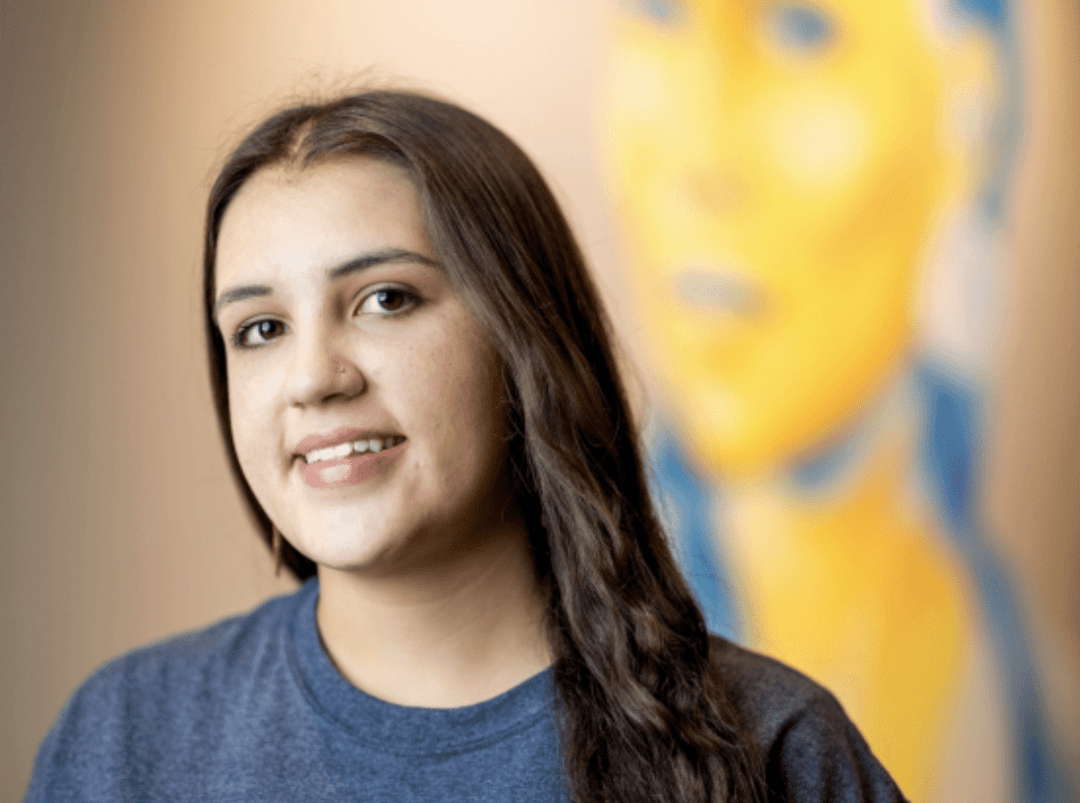
BOZEMAN — When Georgeline Morsette crosses the stage in the Brick Breeden Fieldhouse on Friday during Montana State University’s 139th commencement ceremony, she’ll celebrate earning a bachelor’s degree and entering a new chapter of life, one where she looks forward to working as an art educator in Montana.
The ceremony will be the culmination of Morsette’s college career at MSU in which she has successfully completed her coursework, charted a career path, earned the respect of professors and staff members, and volunteered in her community, according to several who have worked with her. Morsette will receive a degree in art education, K-12 broadfield teaching option.
But there were times when Morsette wasn’t sure she would finish her degree. During her time at MSU, she said, “life hit (her) like a train,” and the challenges were daunting. To reach the commencement milestone is significant, she said, and she’s glad she persisted.
“It’s been a long journey,” Morsette said. “I’m really glad to be at this point.”
Morsette enrolled at MSU in the fall of 2017 after graduating from high school in Billings.
“I’ve always loved art and working with kids and teaching, so I think ever since I graduated high school, I knew I wanted to go to school to be an art teacher,” she said.
She said she was inspired to study art education because her dad had wanted to be an art educator. He had enrolled at MSU too, but, she said, life got in the way of him completing his degree — her parents both started taking classes at MSU when she was just 3 weeks old.
“It turns out school is really hard with a newborn baby, and in a way I am getting this degree for both of us,” Morsette said. (Her mother ended up graduating about a decade later from MSU Billings.)
Morsette also knew she wanted to study at MSU. She is an enrolled member of the Chippewa Cree tribe and grew up in several Montana communities, including Rocky Boy, Bozeman, Belgrade and Billings. She and her parents lived in MSU’s on-campus housing for students with families when she was young. She remembers loving Bozeman and wanted to return.
Morsette has been deeply involved in a number of activities during her time at MSU, including as a member of the American Indian Council and the Society of INdigenous Educators and as an ambassador for the College of Arts and Architecture. Her art has been featured at American Indian Heritage Day and in MSU’s Missing and Murdered Indigenous Women and Girls exhibit in the Strand Union Building. She also served as a community assistant in MSU’s Student Apartments, and she volunteered with the HRDC’s summer lunch program, MSU’s Bounty of the Bridgers food pantry and as a tutor in local schools with the America Reads, America Counts program. Her motivation for her volunteer work has been simply to be kind and make people feel welcome, Morsette said.
When MSU’s American Indian Hall opened in October 2021, Morsette was at the podium, speaking as a representative of the MSU American Indian Council to the more than 1,000 people who attended.
The experience was “meaningful but also terrifying,” Morsette recalled. She said she spoke about the importance of having a Native community at MSU.
“Even though I didn’t come straight from my reservation, having that community is something that’s really important,” she said. “It can be really hard to come to a whole new place and hard to stay unless you feel you have that community.” The American Indian Hall has enabled MSU’s Native community to hold more events and to grow in numbers, Morsette said.
“It’s so nice to have a bigger space for Native students to come in and feel welcome,” she said.
In fact, Lisa Perry, director of American Indian/Alaska Native Student Success Services, said Morsette has helped strengthen her community.
“George always engages and brings good energy into anything she is involved with,” Perry said. “She genuinely cares about her community.” In 2021, Morsette received the Daniel Voyich Community Involvement award given by the MSU Department of Native American Studies and the American Indian/Alaska Native Student Success Program.
As Morsette progressed through college, the increasing difficulty of her classes and the number of activities she participated in started to leave her feeling overwhelmed, she said. She had to learn to say “no” to some things and that it was important to seek out help when she needed it, even if that went beyond academic help.
“I could feel myself start to struggle,” she said. “I was getting burned out and my classes were getting harder. It was harder to find the motivation to get out of bed each day and go to class.”
Morsette sought help for her mental health, working with staff in MSU’s Counseling and Psychological Services. Working with a counselor was new for her, Morsette said: She has many siblings, and she has always been the one in her family who has given help, not needed it.
“But I realized it’s OK to ask for help, too,” she said. “I know I’m strong, but even strong people need help. … It was good to get the help I needed.”
Other challenges came, too. Morsette, who had transferred some credits from summer courses she took at Stone Child College in Rocky Boy, was originally on track to graduate from MSU in three years, she said. But the COVID-19 pandemic hit just as she was getting ready to student-teach, and she knew she didn’t want to complete that portion of her education virtually.
“I just felt like it wouldn’t prepare me for the classroom,” she said. Instead, she took classes in Native American studies, but by the spring of 2021, her mental health was “not great” and she also needed to save money for school and living expenses. So Morsette took a year off from MSU.
She said it was a tough decision and she was worried that she might not return.
“I was scared because many people told me how hard it would be to come back,” she recalled. “But I think that’s part of what motivated me to come back. I’m really stubborn. And I came so far and worked so hard to not go back and finish my degree.”
Ultimately, she said the time off “gave me a renewed sense of purpose and the rest that I needed to come back.” She re-enrolled at MSU in the spring of 2022 and completed her student teaching this semester in Billings, teaching high school ceramics.
Now, as she looks back on her time at MSU, she feels grateful for the professors and staff members who supported her along the way. For example, “everyone” in the education department was always kind and welcoming, she said.
“They genuinely care about you and want you to succeed. And if you ever need help, they’re always there to help you,” she said. “I definitely wouldn’t have made it if I hadn’t had tons of people to help me through.”
In addition, she said her academic work taught her lessons she will carry with her throughout her career. One art methods class taught by Paul Waldum was especially memorable.
“That class showed the importance of creativity and of teaching creative thinking, critical thinking skills and out-of-the-box-type thinking,” she said. “Art education is so much more than doing art.”
As she looks ahead to life after graduation, Morsette isn’t sure what’s next. She would like to find a job teaching art somewhere in Montana, as her partner has one more year left at MSU. She has also considered enrolling in a master’s program.
One thing she does know is that, as she reflects on the impact her teachers have had on her life, she looks forward to someday being an important person in her own students’ lives.
“I’ve had amazing teachers in my life,” Morsette said. “Growing up, life wasn't always easy, but school was a place I enjoyed going because of those great teachers and mentors who inspired me. They made a safe place for me and made me excited to learn. That's what made me want to be a teacher; I want to be that for my own students one day.”
Joe Hicks, assistant dean in the College of Education, Health and Human Development, predicts that Morsette will be just that, calling her a “natural educator” who exhibits great joy and enthusiasm for the learning process.
“Georgeline invests so much into fostering caring and supportive student relationships,” Hicks said. “Her future teaching career is so bright, helping to make the world of art accessible to all students.”




News Comments
Thank you
Open Auditions for Annie
Monday, Sep. 16, 2024
I’m at the Bozeman airport where your painting, “Blowing East” is displayed. It’s absolutely gorgeous! Bravo, Marci!!
The Artists’ Gallery in Bozeman’s Emerson Cultural Center May Exhibits
Sunday, Jun. 30, 2024
This is so typical of a sign in, which we should not have to do to check if we or some one in our party got a permit. I have been working or "creating an account" for 30 minutes and just get the same ...
Smith River permit drawing results available
Sunday, Mar. 10, 2024
I have struggled with this podcast and my own participation therein, the event itself obviously traumatic, but beyond that my inability to reach anyone and convey anything resembling truth. The person ...
Billings, MT Case Becomes True Crime Podcast | 'An Absurd Result'
Marktokarski
Saturday, Jan. 20, 2024